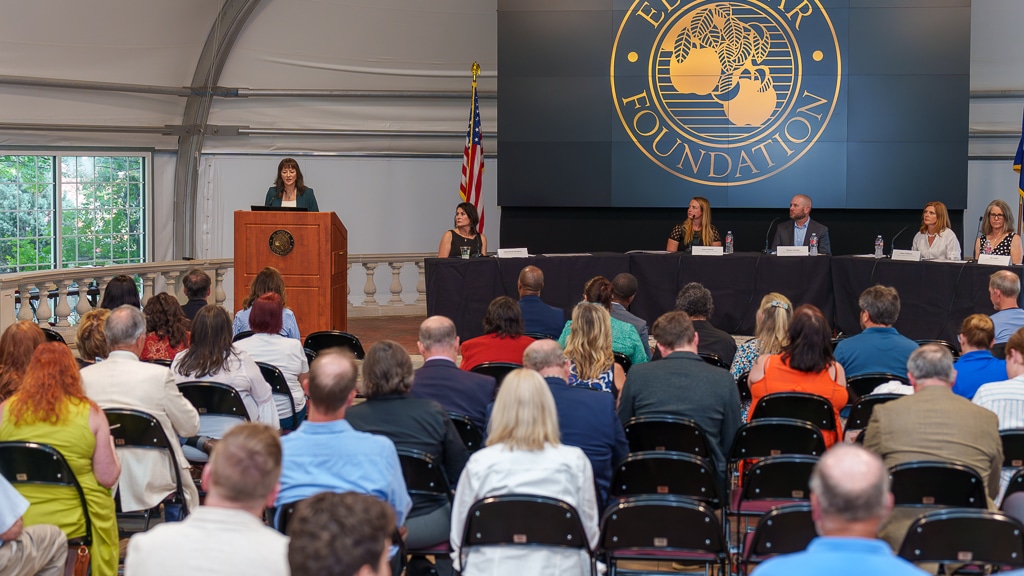On June 21, 2024, El Pomar’s Forum for Civic Advancement held a moderated discussion at El Pomar’s Penrose House Garden Pavilion regarding attainable housing in Colorado Springs. Dedicated to enhancing the civic health of the Pikes Peak region through conversation and debate, Forum for Civic Advancement has held events focused on public policy issues since 2002. With the endless pursuit for attainable housing growing increasingly challenging for many Coloradans, this panel aimed to explain how the current circumstances came to be and in what ways they can be remedied.
Moderated by Johnna Reeder Kleymeyer, President and CEO of the Colorado Springs Chamber & EDC, the panelists included: Darsey Nicklasson, President and Founder of DHN Planning and Development; Thomas Garmong, Market Leader and Division President at Oakwood Homes; Katie Sunderlin, Senior Affordable Housing Coordinator for the City of Colorado Springs; and Jill Gaebler, Executive Director for Pikes Peak Housing Network. With each of their unique areas of expertise, this panel was well-equipped to discuss the topic at hand.
Reeder Kleymeyer began the panel by creating an important distinction between affordable and attainable housing. While the terms are often used interchangeably, they refer to different classifications of housing. Affordable housing is often subsidized housing in which the government exchanges a low-interest loan for a deed restriction to keep the rent low. Attainable housing serves those who make around 80 – 100 percent of the area median income (AMI) in that county. Currently, there is a dramatic lack of attainable housing across Colorado Springs. From young adults looking to buy their first home to elderly individuals looking to downsize, everyone is left scrambling to find long-term housing.
With the framework for the discussion established, the conversation moved to identifying the root of the problem and potential solutions. Gaebler was quick to highlight the impact of the 2008 financial crash when houses ceased to be built in the quantities necessary to accommodate the growing population. According to Common Sense Institute, to meet the city’s growth, there needs to be an increase of 6,000-8,000 units annually. In 2023, there were only 2,665 units constructed. This trend illustrates the crux of the issue: there is simply not enough housing to meet the needs of the entire community. However, the problem is not that simple and there are a whole host of reasons why housing construction continues to fall short of necessary metrics.
Panelists continued to dissect the contributing factors for the housing crisis. With statistics showing that housing costs have risen over 100 percent in the last 10 years with only a 36 percent increase in income, individuals across Colorado are being priced out of the housing market. This can be attributed to many reasons including high-interest rates, inflation, lack of tradesmen qualified to build homes, zoning laws, threatened litigation against builders, and policy impositions to make housing more sustainable that, some believe, make it more expensive. However, with complicated causes emerge creative solutions from the community. Panelist suggestions for addressing these issues ranged from partnerships with faith-based organizations to create housing communities on their land; shifting the focus to infilling underutilized land with new builds in existing and even mature neighborhoods, rather than annexation which requires new infrastructure; and passing legislation that has been created with the input of those involved in the issue.
Although the housing crisis is persistent and complicated, the panelists agreed upon one central goal to pursue as a starting point for addressing these issues: ensuring that there is available housing for every income level with a specific focus on middle housing, such as condominiums (condos). While closing the 16,000-27,000 unit housing deficit will take time, focusing on pathways toward construction of multi-family options, such as condos, “brownstones” and other connected, less expensive housing in the meantime could help alleviate a portion of the stress falling on many Coloradans’ shoulders. However, with significant barriers hindering the development of such options including labor shortages, increased material costs, and heightened legal action against contractors, achieving this goal will require specific attention from those in the attainable housing discussion.
El Pomar’s Forum for Civic Advancement appreciates the work that each panelist is doing in our community to address housing needs and hopes that the conversation regarding attainable housing can continue progressing, and, eventually, solve these systemic issues.



